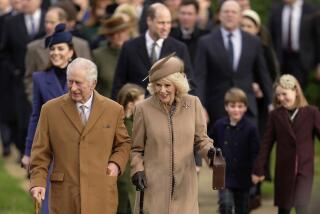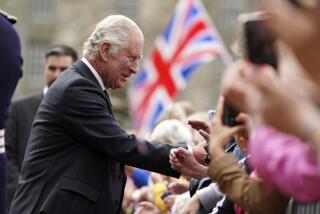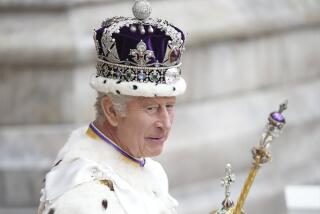THE WORLD - News from May 17, 2009
- Share via
LONDON — Monarch. Tyrant. Reformer. Husband from hell.
King Henry VIII, who took the throne 500 years ago last month, went on to transform Britain. He married six times and sent two of his queens to the executioner. His battle to divorce his first bride led him to break from the Roman Catholic Church and establish the Church of England.
He still divides opinion.
“He was an awful person,” said Brett Dolman, a curator at Hampton Court Palace, Henry’s residence southwest of London. “Emotionally twisted, a bully.”
His colleague, Suzannah Lipscomb, is a bit more forgiving.
“I wonder sometimes whether I am the first female sympathizer with this monstrous tyrant,” said Lipscomb, who is overseeing anniversary exhibitions at Hampton Court and has written a book about Henry. “I’m not sure I like him, but I think I have a lot more insight into why he did what he did.”
Lipscomb said Henry’s influence on Britain was huge.
“He marked the transition from a medieval state to a modern state. He founded the Church of England. He swaggered out and claimed a place for England on the European stage that it has held ever since, despite its size.”
Henry is probably Britain’s most famous monarch, instantly recognizable from Hans Holbein’s portrait of a stout, bearded man in a black-and-white hat.
Hampton Court, the sprawling red-brick Tudor palace that was a favored retreat for the king and his court, draws tourists by the busload to its grand state apartments, cavernous kitchens and 500-year-old tennis court, as well as its 60 acres of riverside gardens and famous hedge maze.
Knowledge of its former resident, however, tends to be limited to a few facts.
“His wives and the creation of the Church of England,” said Matt Cicinelli, 22, visiting from Washington, D.C. “Overall, just a monarch who did what he wanted to do.”
“I haven’t heard entirely positive things about him, to be honest,” said his friend, Tom Peterson.
Britain’s museums and palaces are using the anniversary to take a closer look at the man behind the image.
Many have mounted special exhibitions to mark the occasion. Venues include Windsor Castle, one of the homes of the current monarch, Elizabeth II, and the place where Henry is buried alongside his third wife, Jane Seymour, who bore him a son.
The British Library is showing off a large collection of Henry’s books -- many annotated by him -- in an attempt to get inside his mind. The National Archives is exhibiting original documents from Henry’s reign, including a parchment roll recording his second wife Anne Boleyn’s trial for high treason, with its lurid allegations of adultery and incest.
There’s also a major television series hosted by historian David Starkey, who calls Henry “our most important single ruler.”
Henry took the throne on April 21, 1509, as a svelte and athletic 17-year-old with a passion for jousting -- not too far from the lithe, sexy figure portrayed by Jonathan Rhys Meyers in Showtime’s popular TV series “The Tudors.”
By the time he died in 1547, crippled by leg ulcers, his waist measured 55 inches.
The king’s expanding girth can be charted in a Tower of London exhibition devoted to Henry’s suits of armor.
Bridget Clifford, who curated the Tower exhibition, said that in the popular imagination Henry is “an elderly tyrant . . . a large, rather overbearing figure, almost geometric, with triangular shoulders.”
The early armor is that of a popular warrior king eager to win the hearts and minds of his subjects -- especially the women.
Well educated, he spoke several languages and was a patron of the arts. But he also had political rivals, former friends and two of his wives -- Boleyn and Catherine Howard -- arrested, locked in the Tower of London and beheaded.
“Clearly, at the beginning of his reign he was quite a catch -- ebullient, charismatic, handsome,” said Dolman, who has put together a touching exhibition at Hampton Court devoted to the women in Henry’s life -- his put-upon wives and his two daughters, Mary and Elizabeth.
“He’s a horrid person, but he is a passionate person and he loves -- passionately loves -- at least four of his wives,” Dolman said.
Henry’s passion for Anne Boleyn led him to seek divorce from his first wife, Catherine of Aragon, who had failed to produce a male heir. The Vatican’s refusal to annul the marriage led Henry to reject the authority of the pope and install himself as head of the Church of England. Under his successors, England became a resolutely Protestant nation.
The schism and Henry’s dissolution of the affluent monasteries shifted power in England from church to state. His wars ensured England was a major player in Europe, and the shipyards he founded helped produce a globe-girdling navy.
Although he was obsessed with siring a future king, his only legitimate son, Edward VI, died at 15.
His daughter, Elizabeth I, went on to rule for 45 years and oversaw one of England’s greatest eras.
Lipscomb said it’s important to realize “how important he is to our sense of national identity.”
“Although we are horrified by him, we are proud of him as well,” she said. “He symbolizes English identity. The key is in that stance, which is powerful and majestic.”
Even the king’s famous bulk seems fitting to this calorie-loving nation.
“He looks like a lot of English men, doesn’t he?” Lipscomb said. “We are familiar with the girth.”
More to Read
Sign up for The Wild
We’ll help you find the best places to hike, bike and run, as well as the perfect silent spots for meditation and yoga.
You may occasionally receive promotional content from the Los Angeles Times.






